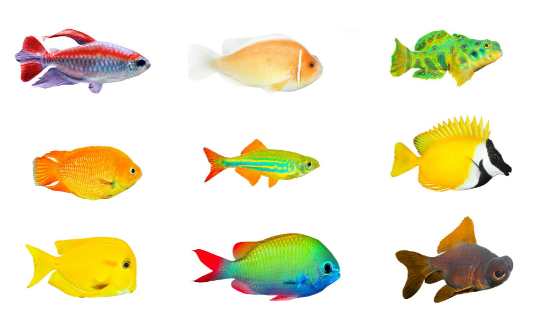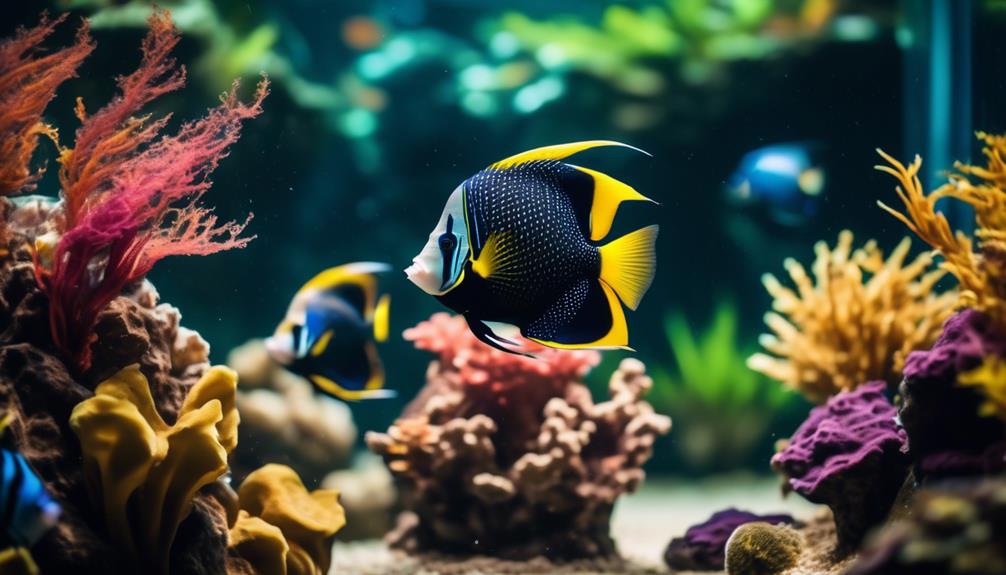
Are you ready to dive into the fascinating world of angelfish care?
Like a hidden treasure waiting to be discovered, these graceful creatures hold secrets that will captivate any aquarium enthusiast.
From the tank requirements that mimic their natural habitat to the ideal companions that will bring out their best qualities, there is so much to learn about creating the perfect environment for angelfish.
And that’s just the beginning! Stay tuned as we uncover the secrets of feeding, breeding, and maintaining these mesmerizing creatures.
Get ready to unlock the mysteries of angelfish care, and embark on a journey that will leave you wanting more.
Key Takeaways
- Angelfish require a minimum tank capacity of 50 gallons and prefer a tall aquarium.
- Ideal tank mates for angelfish include cardinal tetras, congo tetras, red-nosed tetras, clown loaches, and rams.
- Creating the perfect angelfish habitat involves providing freshwater, dimly lit tanks with hiding spaces such as plants, rocks, and driftwood.
- Proper care for angelfish includes regular water changes, providing an appropriate tank size, a suitable diet, and monitoring water parameters.
Angelfish Tank Requirements
To meet the tank requirements of angelfish, you’ll need a large aquarium with a capacity of at least 50 gallons. These freshwater fish grow to a medium size, reaching up to 12 inches in height and 6 inches in diameter. With their community aggressive temperament, it’s important to provide them with enough space to swim comfortably. Angelfish prefer the middle region of the tank and need a tall aquarium to accommodate their tall body shape.
They also prefer dimly lit tanks with hiding spaces. To create a suitable environment for angelfish, consider adding tank mates such as Cardinal Tetras, Congo Tetras, Red Nosed Tetras, Clown Loaches, Rams, Clown Plecos, and Bristle Nosed Plecos.
Ideal Tank Mates for Angelfish
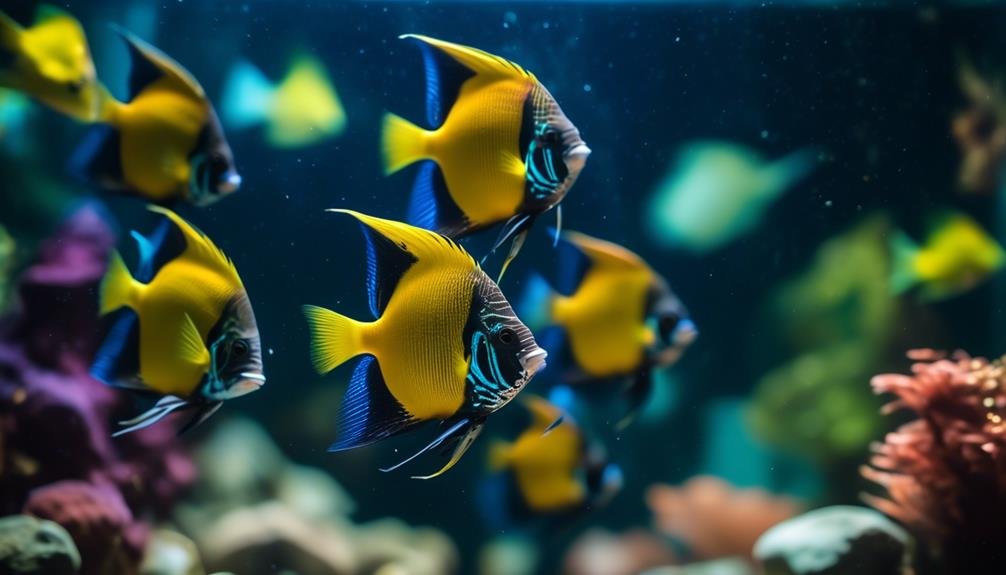
Angelfish thrive when kept with suitable tank mates that complement their temperament and tank requirements. Here are some ideal tank mates for angelfish:
| Suitable Tank Mates |
|---|
| Cardinal Tetras |
| Congo Tetras |
| Red Nosed Tetras |
| Clown Loaches |
| Rams |
| Clown Plecos |
| Bristle Nosed Plecos |
These tank mates are compatible with angelfish because they share similar water temperature and pH requirements. Additionally, they are peaceful species that won’t intimidate or harass the angelfish. The tetras add vibrant color to the tank, while the loaches, plecos, and rams provide interesting behavior and variety. It’s important to note that angelfish can be territorial during breeding, so it’s recommended to provide ample space and hiding spots for the tank mates. By choosing these suitable tank mates, you can create a harmonious and visually appealing aquarium environment for your angelfish.
Creating the Perfect Angelfish Habitat
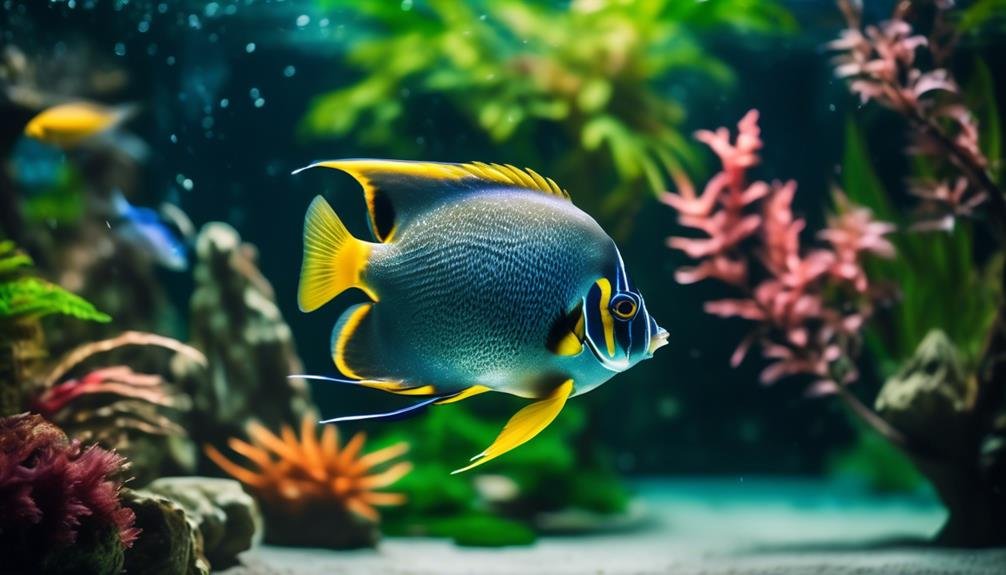
When setting up the perfect habitat for your angelfish, it’s important to consider their specific tank requirements and preferences.
Angelfish are freshwater fish that reach a medium size of up to 12 inches in height and 6 inches in diameter. They have a community aggressive temperament and require a large aquarium of 50+ gallons.
These fish prefer swimming in the middle region of the tank, so make sure the aquarium has sufficient height to accommodate their tall body shape. Angelfish also prefer dimly lit tanks with hiding spaces.
To create the ideal habitat, consider adding plants, rocks, and driftwood for them to hide and explore. Providing suitable tank mates such as cardinal tetras, congo tetras, and clown loaches can also help create a harmonious environment for your angelfish.
Maintaining and Caring for Angelfish
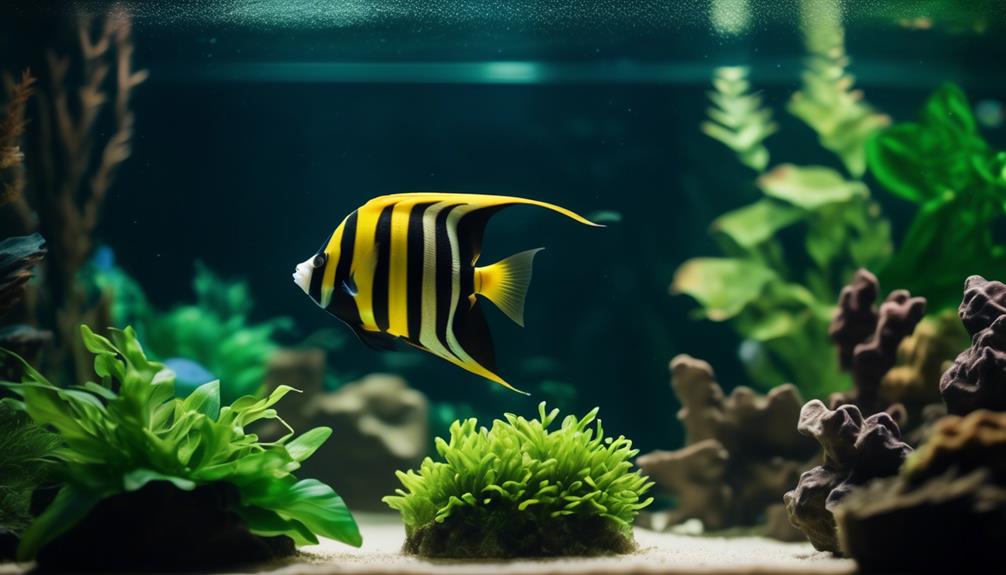
Proper care and maintenance of angelfish is essential for their health and longevity. To ensure that your angelfish thrive in your aquarium, here are some important tips to keep in mind:
- Regular water changes: Angelfish require clean and well-maintained water to stay healthy.
- Appropriate tank size: Provide your angelfish with a spacious aquarium that allows them to swim freely.
- Proper diet: Feed your angelfish a balanced diet of live foods, such as bloodworms and brine shrimp, along with flake or pellet-based foods.
- Suitable tank mates: Choose compatible tank mates, such as cardinal tetras or clown plecos, to prevent aggression and stress.
- Monitoring water parameters: Regularly test the water for pH, ammonia, and nitrate levels to ensure they’re within the appropriate range.
Feeding Angelfish: Best Practices
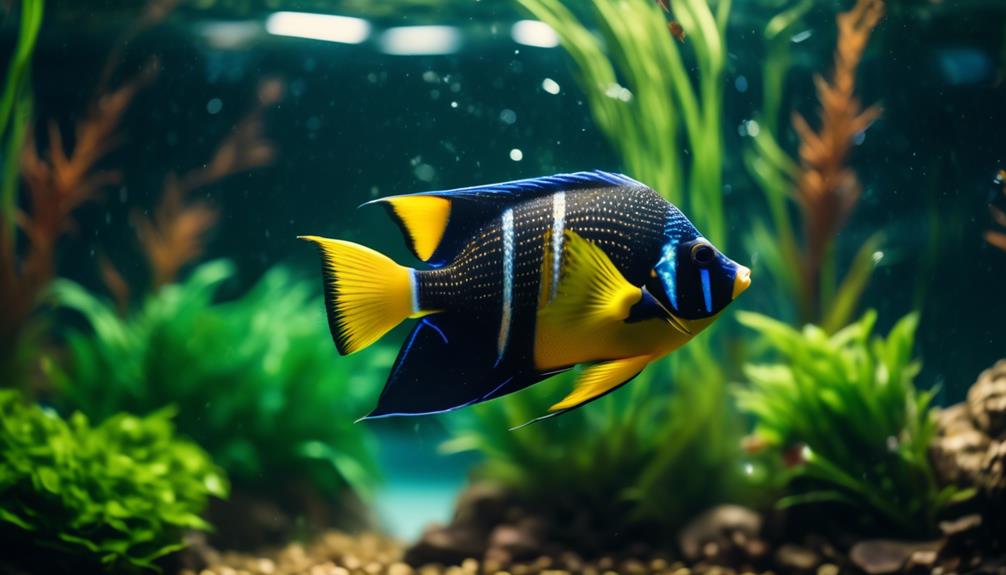
To ensure optimal nutrition for your angelfish, it’s important to follow best practices when feeding them.
Angelfish are carnivorous species and thrive on live foods such as bloodworm, brine shrimp, mosquito larvae, and tube worms. They can also be fed chopped beef liver.
Additionally, angelfish readily accept most flake and pellet-based foods. It’s important to provide a varied diet to ensure they receive all the necessary nutrients.
Feeding them a combination of live foods and high-quality commercial foods will help maintain their health and vitality.
Remember to feed them small amounts multiple times a day, as angelfish have small stomachs and can easily overeat.
Understanding Angelfish Breeding Behavior
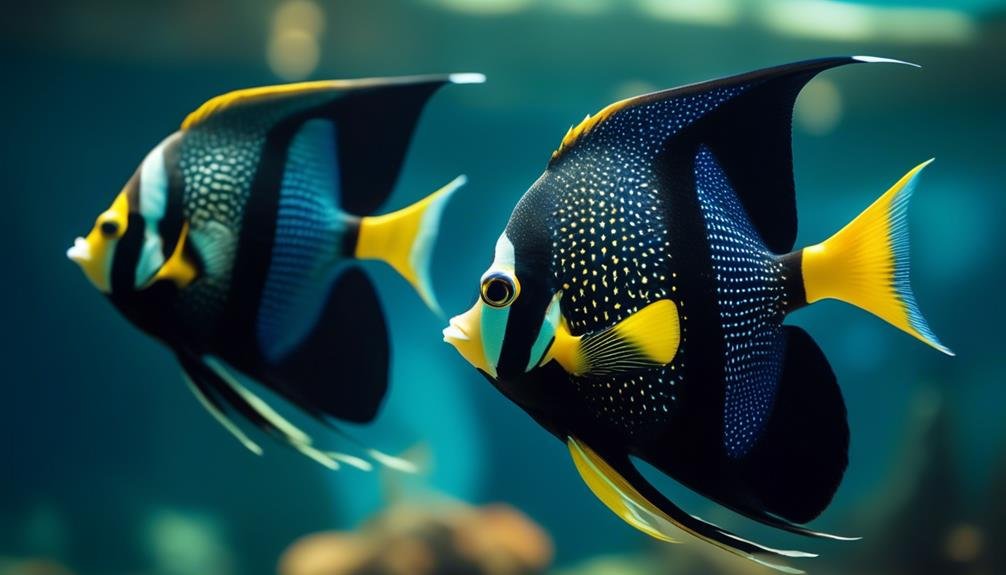
As you continue to learn about angelfish care and maintenance, it’s important to understand their breeding behavior. Here are five key points to consider:
- Angelfish are difficult to sex, but males may develop a slight bump on their heads when breeding.
- Females may display a small tube-like egg spot near their ventral openings.
- They lay their eggs on flat surfaces, such as broad leaf plants.
- Both parents actively guard the eggs.
- Angelfish will readily spawn in suitable water conditions and space.
Identifying Angelfish Gender: A Guide
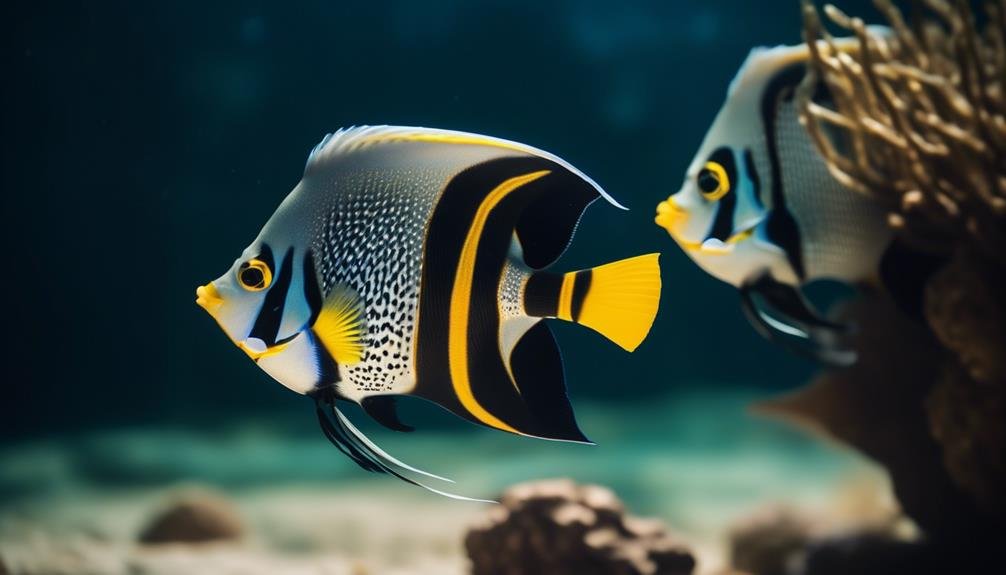
Determining the gender of angelfish can be challenging, but there are some physical characteristics that can help you identify males and females.
One key difference is in the shape of their bodies. Males tend to have a more triangular shape, with a pointier dorsal and anal fin. Females, on the other hand, have a rounder body shape, with a slightly shorter anal fin.
Another way to distinguish between the genders is by examining their breeding tubes. Males have a small bump on their foreheads, known as a nuchal hump, which becomes more pronounced during breeding. Females, on the other hand, have a small tube-like protrusion near their ventral opening, called an egg spot.
Setting Up a Breeding Tank for Angelfish
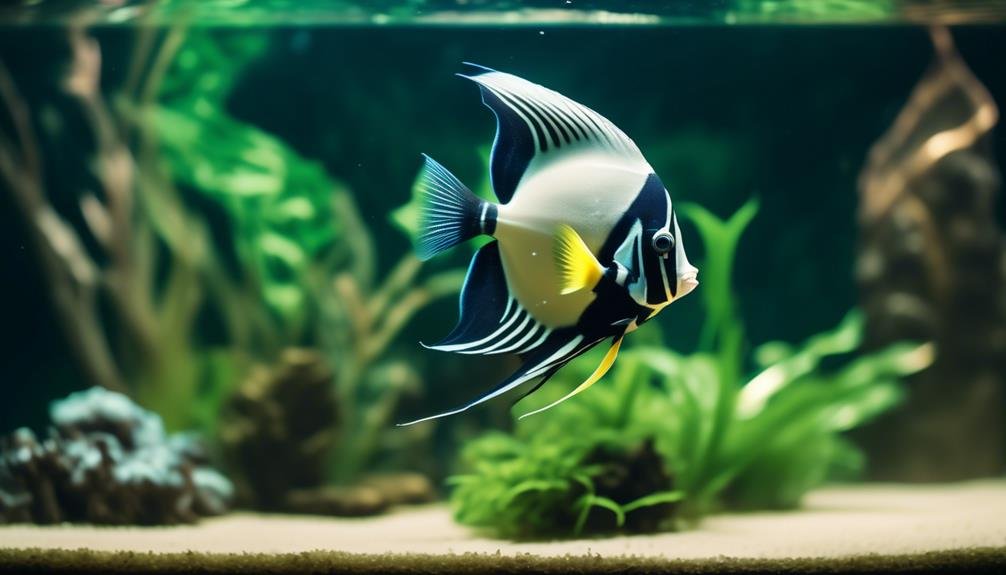
When setting up a breeding tank for angelfish, consider the specific requirements needed to create an ideal environment for successful breeding. Here are some key points to keep in mind:
- Tank Size: Provide a spacious tank with a minimum capacity of 20 gallons to ensure enough space for the angelfish to swim and breed comfortably.
- Water Parameters: Maintain a temperature around 78-82°F, pH level between 6.5-7.0, and soft to moderately hard water for optimal breeding conditions.
- Plants and Decorations: Include broad leaf plants like Amazon swords or Java ferns for the angelfish to lay their eggs on. Additionally, provide hiding spots and vertical structures to mimic their natural habitat.
- Lighting: Use dim lighting in the breeding tank to create a calm and peaceful atmosphere for the angelfish.
- Separation: Separate the breeding pair from other tank mates to minimize stress and potential aggression.
Angelfish Spawning Process: Step-by-Step
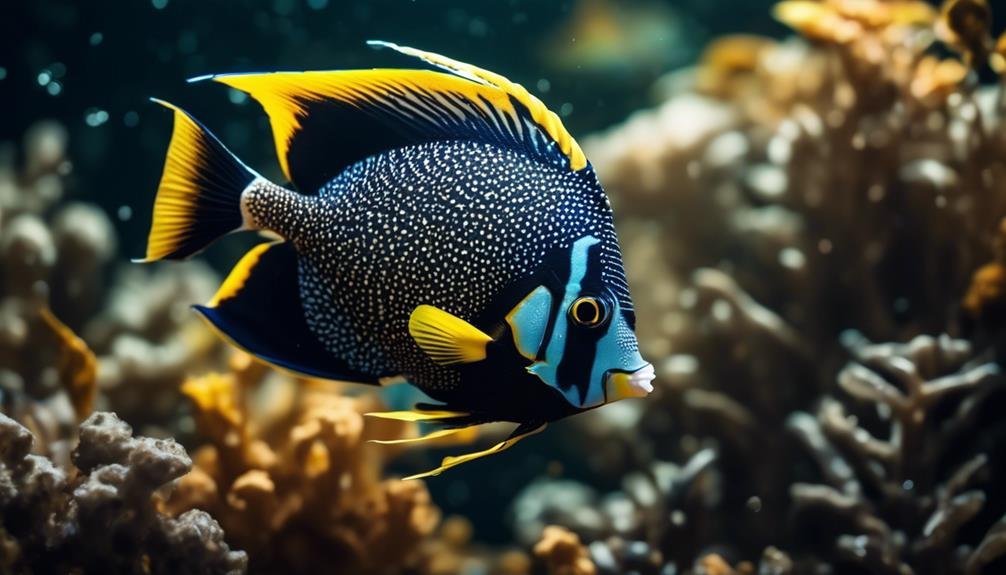
To proceed with the angelfish spawning process, it’s crucial to ensure that the breeding pair is in a separate tank with the appropriate conditions. Start by setting up a separate tank with a flat surface, such as a broad leaf plant, for the angelfish to lay their eggs on. Provide the tank with clean, soft water and maintain a temperature of around 78-82°F.
Next, condition the breeding pair by feeding them protein-rich foods like live brine shrimp and bloodworms. Once the pair is ready, introduce them to the breeding tank and observe their behavior. The male will chase the female, eventually leading her to the chosen spawning site. The female will deposit the eggs, while the male fertilizes them.
After spawning, remove the adult angelfish from the tank to prevent them from eating the eggs. Monitor the eggs closely and provide gentle aeration to keep them healthy. In about 48-60 hours, the eggs will hatch into wriggling larvae.
Raising Angelfish Fry: Tips and Tricks
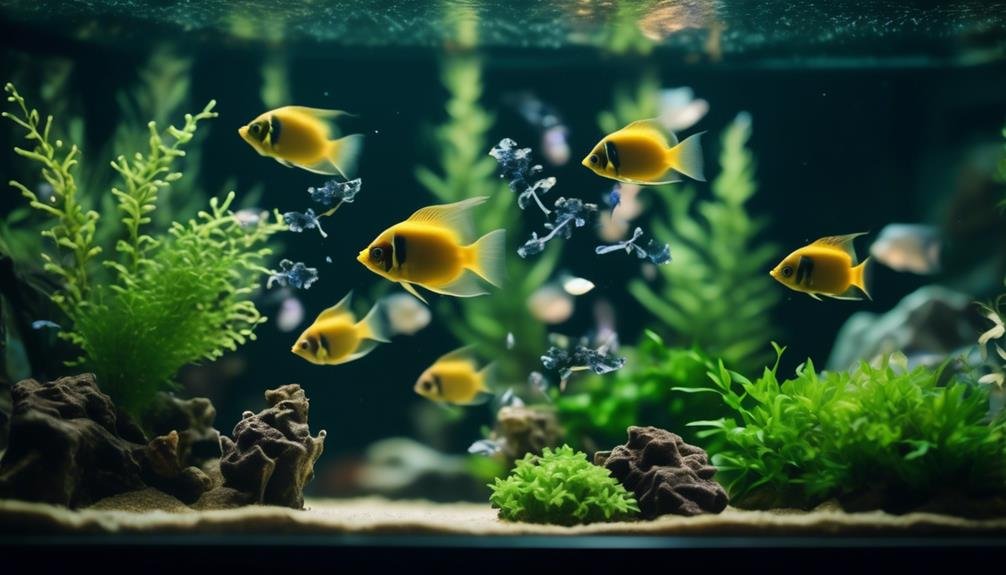
Raising angelfish fry requires careful attention and specific techniques to ensure their healthy growth and development. Here are some tips and tricks to help you successfully raise angelfish fry:
- Separate the fry: Move the fry to a separate tank to protect them from being eaten by adult angelfish or other tank mates.
- Provide appropriate nutrition: Feed the fry with freshly hatched brine shrimp or microworms to meet their nutritional needs.
- Maintain water quality: Monitor and maintain optimal water conditions, including temperature, pH levels, and ammonia levels, to promote the fry’s health and growth.
- Use a sponge filter: Install a sponge filter in the fry tank to provide gentle water flow and prevent the fry from being sucked into the filter.
- Gradually introduce solid food: As the fry grow, introduce finely crushed flakes or pellets to their diet to encourage their transition to adult food.
Common Challenges in Angelfish Breeding
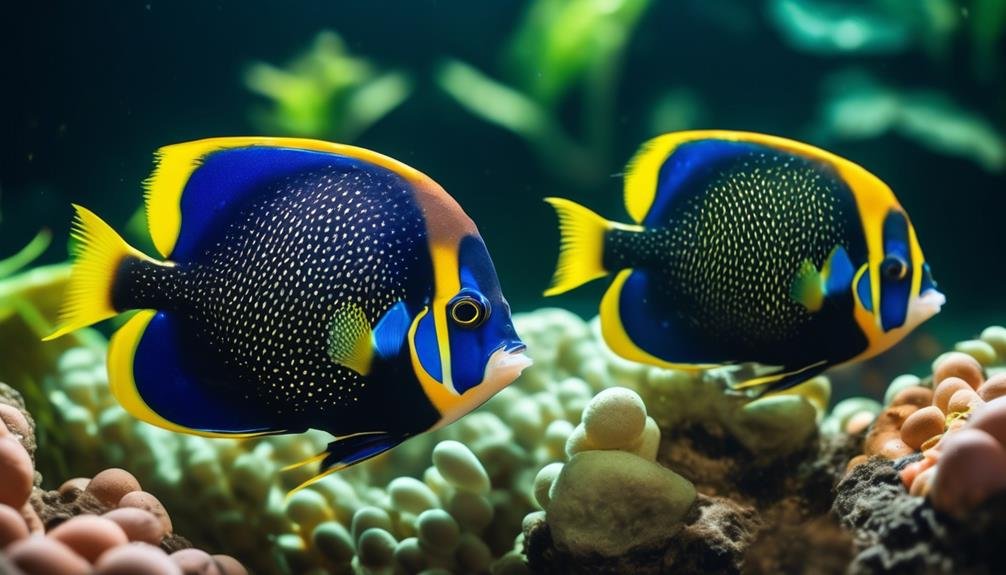
Breeding angelfish can present various challenges that require careful attention and specific techniques for successful reproduction.
One common challenge is determining the sex of the angelfish. It can be difficult to identify the males and females, but there are some subtle physical differences. Males may develop a slight bump on their heads when breeding, while females may display a small tube-like egg spot near their ventral openings.
Another challenge is providing suitable conditions for spawning. Angelfish typically lay their eggs on flat surfaces like broad leaf plants, so it’s important to have these available in the breeding tank. Additionally, both parents play a role in guarding the eggs, so ensuring they’ve enough space and suitable water conditions is crucial for a successful breeding attempt.
Troubleshooting Angelfish Tank Issues
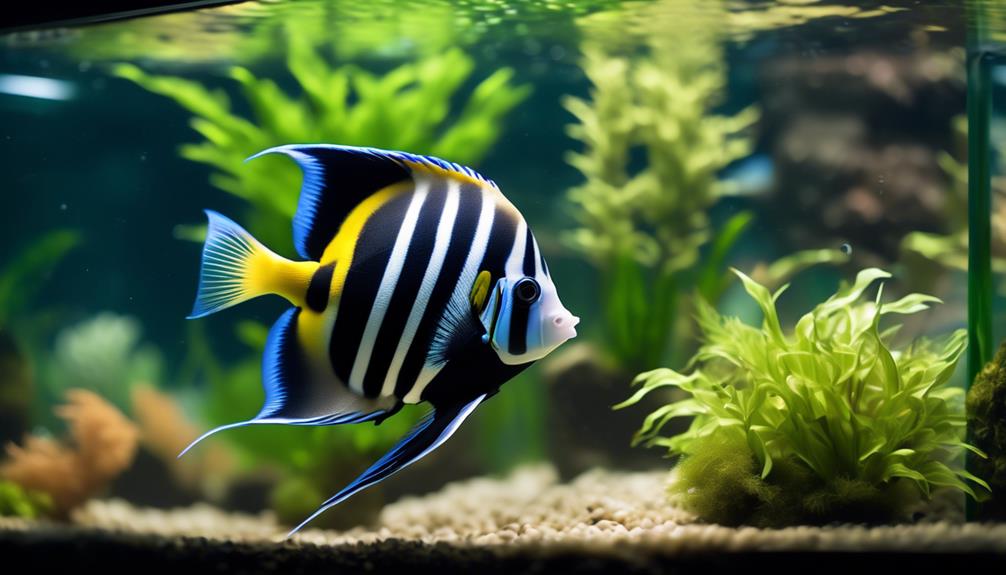
If you’re experiencing any issues with your angelfish tank, there are a few troubleshooting steps you can take to address them effectively.
Here are some tips to help you troubleshoot your angelfish tank issues:
- Check water parameters: Test the water for ammonia, nitrite, nitrate, and pH levels to ensure they’re within the appropriate range for angelfish.
- Monitor tank temperature: Make sure the water temperature is suitable for angelfish, as they prefer warmer water between 76-82°F.
- Evaluate tank filtration: Ensure your tank has adequate filtration to maintain water quality and remove any waste or toxins.
- Assess tank size: Verify that your angelfish have enough space in the tank to swim and thrive comfortably.
- Observe tank mates: Pay attention to the behavior of your angelfish and their tank mates to ensure there are no aggressive interactions or bullying.
Expert Tips for Angelfish Success
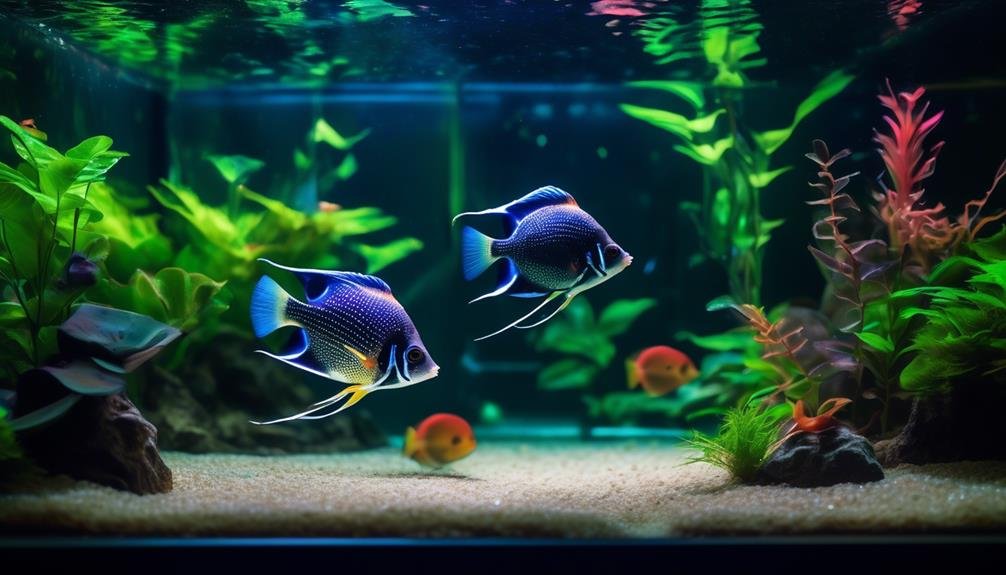
To ensure success in caring for angelfish, it’s important to follow expert tips and guidelines.
First, provide your angelfish with a suitable tank environment. This includes a large aquarium with a minimum capacity of 50 gallons, sufficient height to accommodate their tall body shape, and plenty of hiding spaces. Keep the tank dimly lit as angelfish prefer it that way.
When it comes to tank mates, choose peaceful species such as cardinal tetras, congo tetras, and clown plecos.
In terms of care and maintenance, perform weekly water changes and keep the tank heavily planted with reedy plants. Feed your angelfish a varied diet of live foods like bloodworms and brine shrimp, as well as flake and pellet-based foods.
Lastly, if you want to breed angelfish, ensure proper water conditions and provide flat surfaces like broad leaf plants for them to lay eggs on.
Frequently Asked Questions
Can Angelfish Be Kept in a Small Aquarium or Do They Require a Large Tank?
No, angelfish cannot be kept in a small aquarium. They require a large tank, preferably 50+ gallons. Their tall body shape and aggressive temperament necessitate sufficient space and hiding spots in a dimly lit environment.
What Are Some Suitable Tank Mates for Angelfish Other Than the Ones Mentioned?
Other suitable tank mates for angelfish include gouramis, swordtails, mollies, and platies. These fish have similar water requirements and temperaments, making them compatible companions for your angelfish in the aquarium.
How Often Should Angelfish Be Fed and What Types of Food Are Best for Them?
You should feed your angelfish regularly, ideally once or twice a day. They thrive on a diet of live foods like bloodworms and brine shrimp, but they also accept flake and pellet-based foods.
How Long Does It Typically Take for Angelfish Eggs to Hatch and for the Fry to Become Independent?
Angelfish eggs typically take around 2-3 days to hatch. The fry become independent after about 5-7 days, during which time they are cared for by both parents.
What Are Some Common Challenges That Angelfish Breeders May Face and How Can They Be Overcome?
Common challenges that angelfish breeders may face include difficulty in identifying the sex of the fish, ensuring suitable water conditions for spawning, and protecting the eggs from predators. These challenges can be overcome with careful observation and providing a safe and well-maintained breeding environment.
:Can Angelfish and Dartfish Share the Same Tank?
Yes, angelfish and the hardy dartfish marvel can share the same tank if certain conditions are met. Both species prefer a peaceful environment with plenty of hiding spots and are generally compatible. However, it’s important to monitor their behavior and ensure that there is enough space for both to establish their territories.
Conclusion
In conclusion, angelfish care requires attention to their tank requirements, ideal tank mates, and breeding tips.
Providing a spacious aquarium with dim lighting and hiding spaces is essential for their well-being. Choosing compatible tank mates such as tetras and plecos will ensure a harmonious environment. Regular feeding and maintenance are necessary for their health.
Breeding angelfish requires special considerations and troubleshooting may be needed. By following these expert tips, you can create the perfect habitat for these mesmerizing creatures to thrive.




